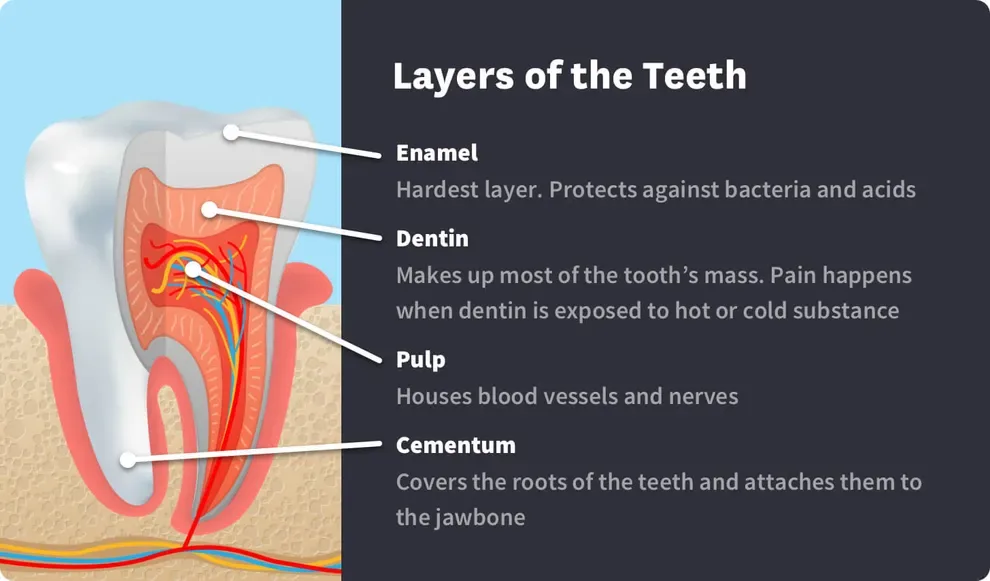How Long Does a Cavity Filling Take? Size & Location Matter

Table of Contents
- Filling Cavities
- Layers of the Teeth
- Types of Dental Cavities
- What Goes Into a Cavity Filling
- References
Every cavity in every patient is different, so there is no one-size-fits-all metric for how long it takes to fill a given cavity.
Depending on the exact placement of the cavity, how big it is, how much it has progressed, what material the dentist uses to fill it, and the patient’s dental health, filling the cavity can be done in 15 minutes, or it could take about an hour.
Filling Cavities
There are many factors that influence how long it takes to fill a cavity. This is primarily because everyone’s cavities are different.
A cavity filling can take anywhere from 15 minutes to an hour, depending on everything from the size, location, and type of the cavity, to the material that the dentist chooses to use to fill the cavity, to the patient’s overall dental health.
To understand how long a cavity filling takes, it’s important to know what a filling is. It is a simple dental procedure that repairs chipped or decayed teeth, when the damage is at most three surfaces deep and the extent of the damage is no more than moderate.

Layers of the Teeth
How long it takes to fill a cavity also depends on the degree to which the cavity has penetrated the layers of the teeth.
Enamel is the outermost layer of the teeth and also the hardest layer. Its function is to protect the teeth from bacteria and acids. It has no cells to regenerate itself, so if a part of the enamel is too badly damaged, it is permanently lost.
Underneath the enamel is the dentin. The dentin constitutes most of the tooth’s mass. When a person has a cavity, the sensitivity they feel is the result of the enamel having eroded and the dentin being exposed to hot and cold substances.
Beneath the dentin is the pulp, which houses blood vessels and nerves. Beyond that is the final layer, the cementum, covering the roots of the teeth and directly attaching them to the jawbone.
A dental cavity affects one layer at a time. As the decay sinks deeper into the teeth, the pain and discomfort also increase. The progression of the cavity through the four layers of the teeth are what determine what kind of filling the dentist uses and how long it takes to fill.
Remember to avoid any hard and sticky foods in addition to candies for at least 24 hours following the procedure because it will crack or dislodge your filling.
Types of Dental Cavities
There are three types of dental cavities.
These are also known as occlusal cavities. They have only affected the enamel. A patient may notice a bad taste in their mouth, painful chewing, chronic bad breath, a tiny hole on the surface of the tooth, and swelling of the gums around the affected tooth.
Occlusal cavities normally only occur on the molars. The molars are situated in the back of the mouth and tend not to get brushed as well as the teeth in the front of the mouth, so the molars are more likely to have bacteria on them.
Occlusal cavities are typically easily treated with fluoride.
Also known as pit cavities, these are found in the deep grooves on the molars. These are common cavities that occur in people who do not regularly brush their teeth because foot particles and plaque (the bacteria that causes tooth decay) can easily grow in these grooves.
A dentist will use a sealant to treat these cavities. Sealants are fine coatings that are placed on the surface of the affected tooth, to hold off against further decay. The sealant bonds to the grooves of the molar and protects the deeper layers from the progression of the cavity.
These form at the root of the teeth, below the gums. The acids in the bacteria affect the cementum, and they typically affect people who have receding gums or poor oral hygiene. Root cavities develop faster than the other type of cavities, so they need more treatment.
A dentist will remove the decayed area of the tooth and use composite resin to fill the affected part. If the cavity is affecting the pulp, the dentist will have to perform a root canal to remove the decayed portions of the pulp, clean the area, and then seal it off from further decay.
If the root cavity is detected in its early stages, treatment is much easier. A deep cleaning will remove all the plaque, and a fluoride treatment will ensure the cavity does not grow any deeper
What Goes Into a Cavity Filling?
As for what the dentist can actually use to fill the cavity, there are several materials that can fit the bill. There are cosmetic options, like gold, which will be more expensive and might take time to prepare. There are tooth-colored and plastic options, which are normally cheaper and quicker to implement.
Overall, the length of time it takes to fill a cavity depends on the size and location of the tooth decay, especially if the extent of the decay is significant. Other factors include the nature of the filling material itself.
